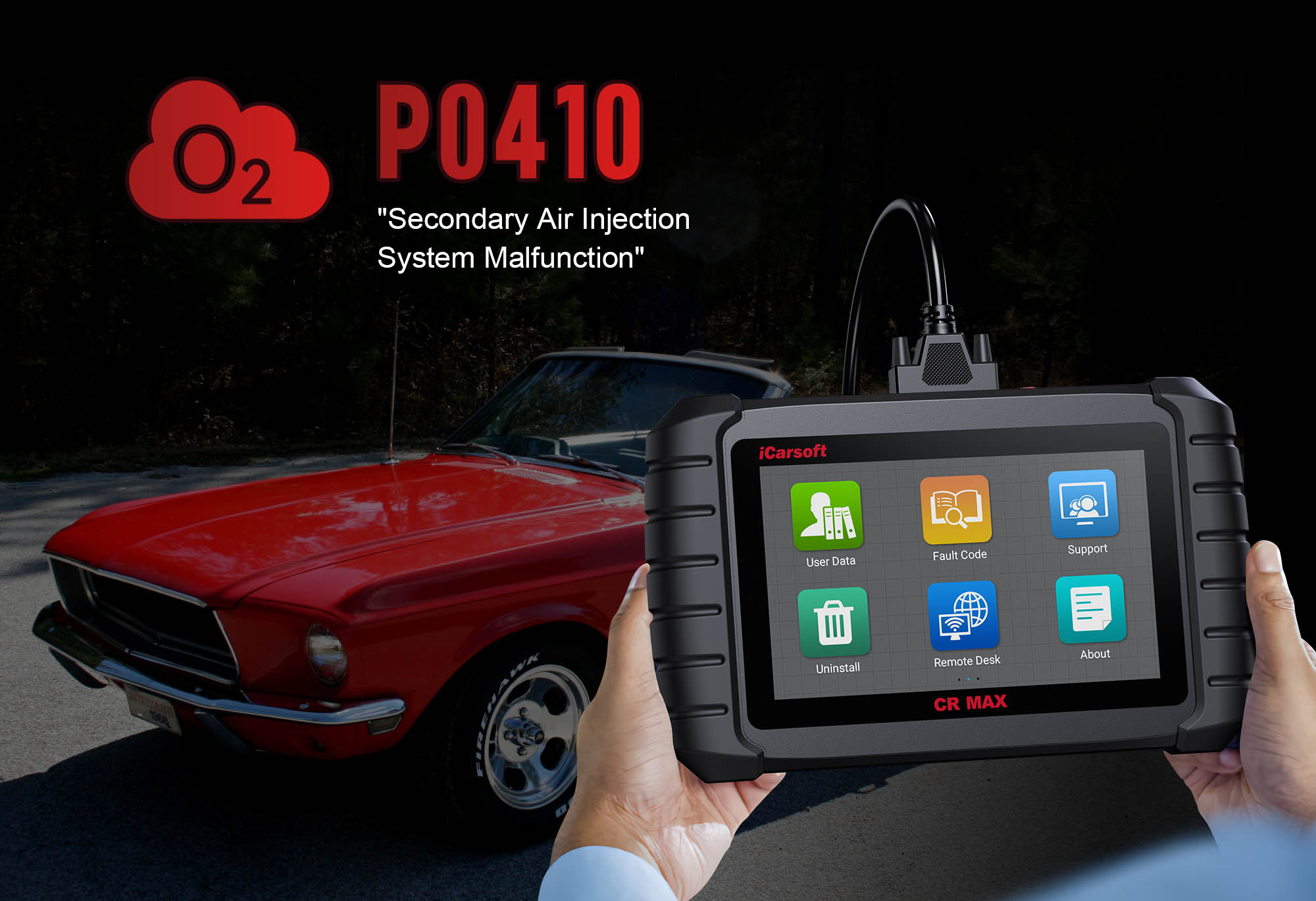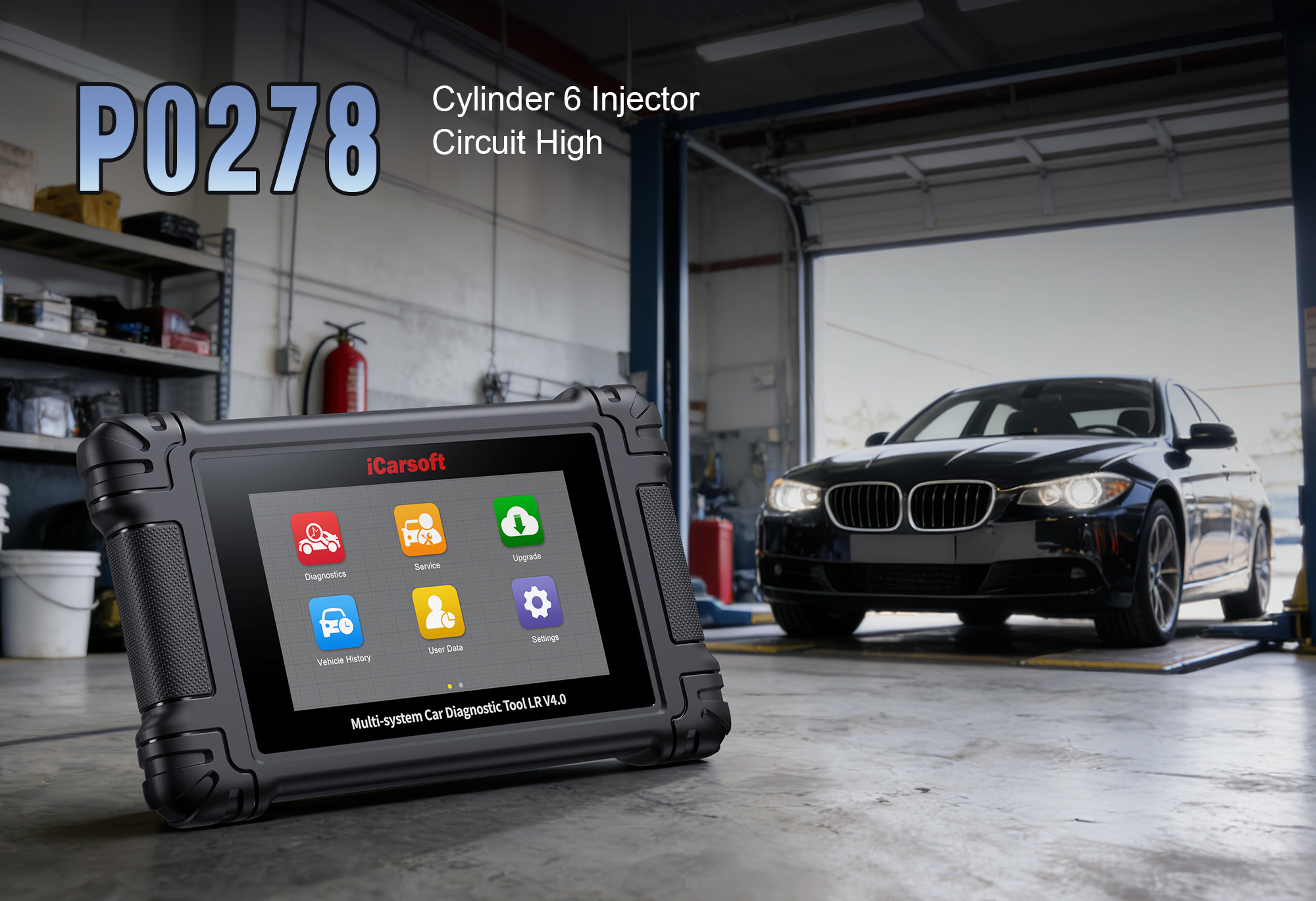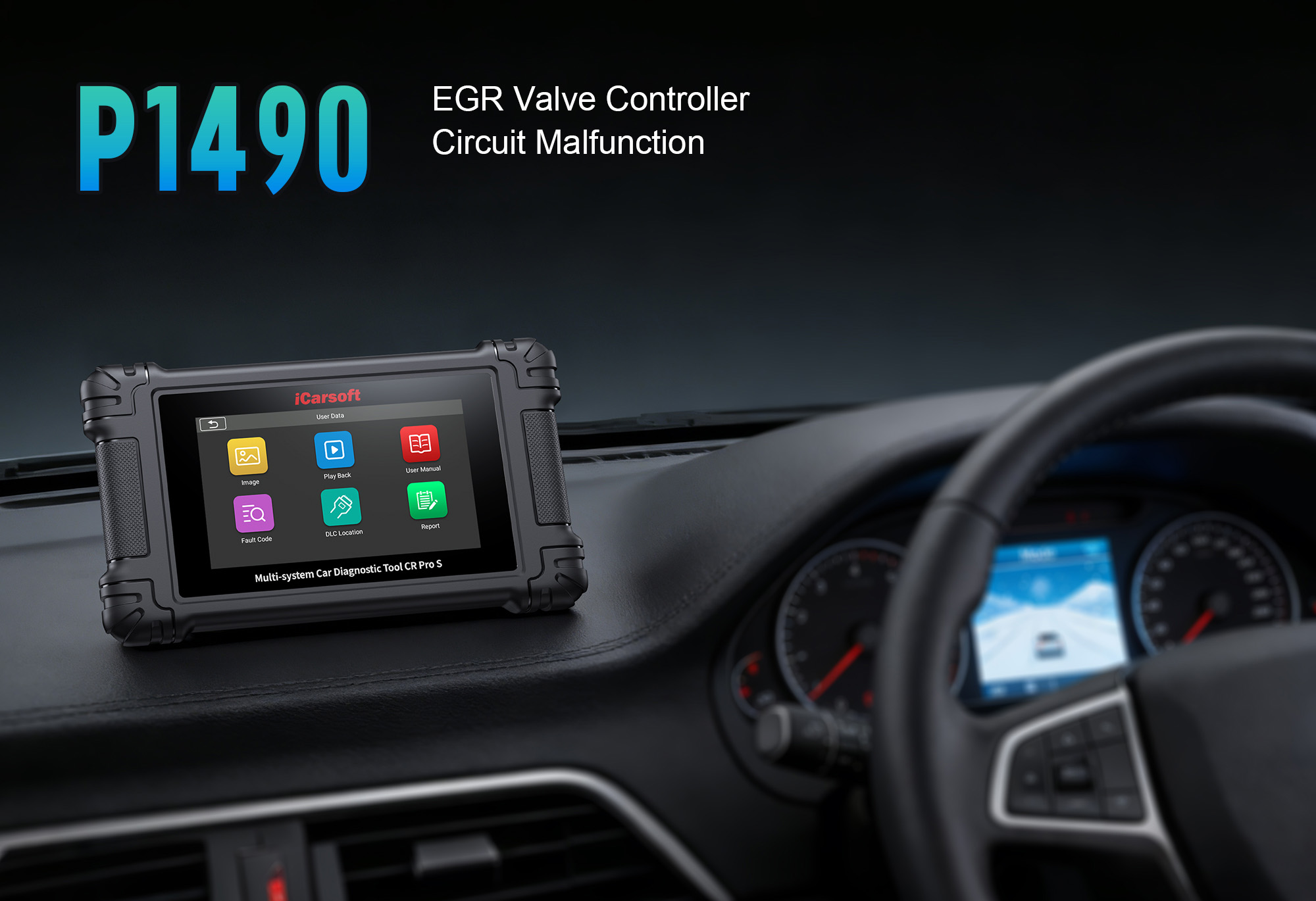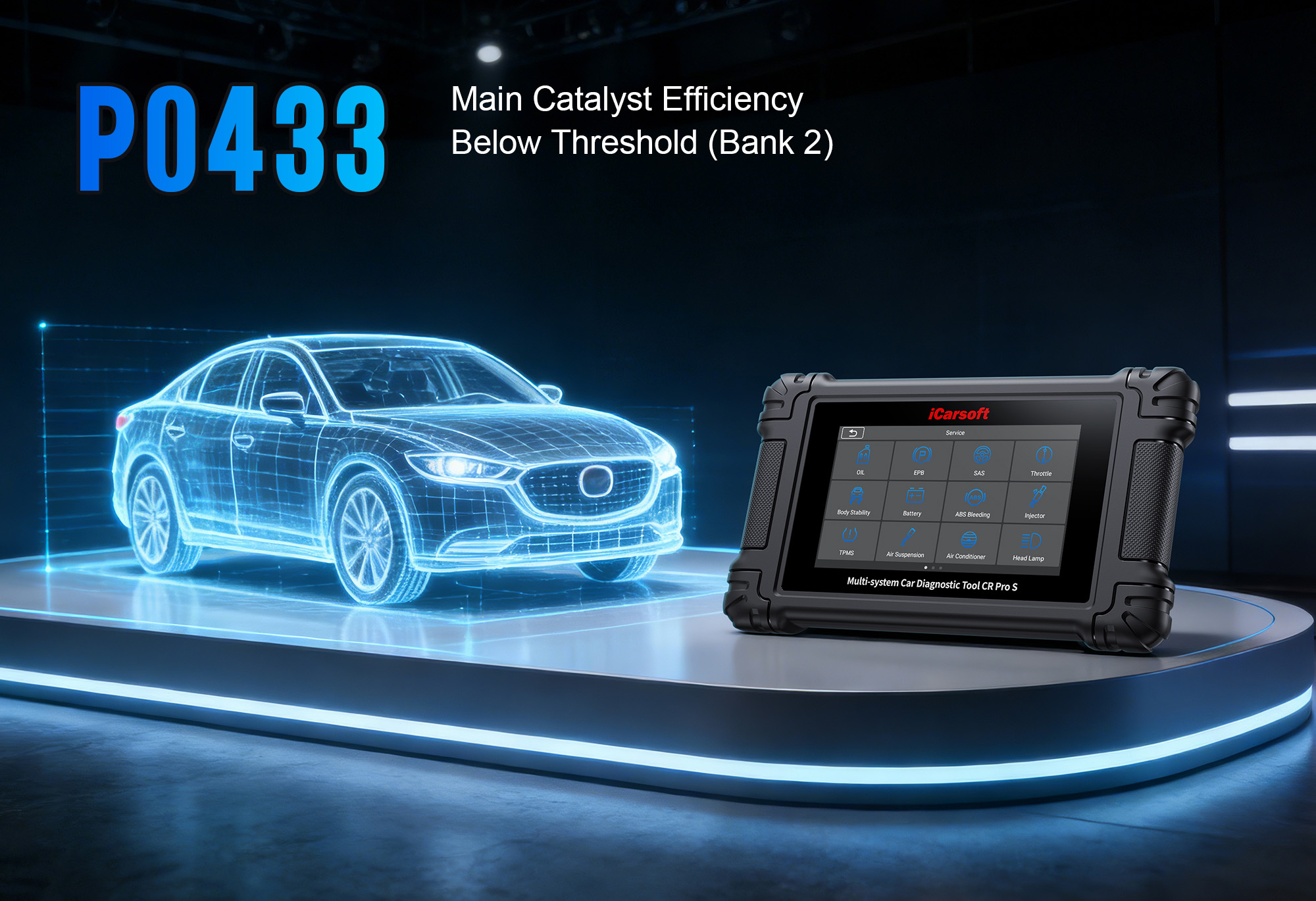P0410 Code: Troubleshooting Secondary Air Injection System Malfunction
A glowing check engine light is your vehicle’s way of sounding an alarm—and the P0410 code is a common signal of trouble in the secondary air injection system (SAIS). This system plays a critical role in reducing emissions, so ignoring P0410 can lead to increased pollution, poor performance, and costly repairs. In this guide, we’ll explain what P0410 means, its symptoms, root causes, step-by-step diagnosis (with the iCarsoft CR MAX), and how to fix it.
What Is the P0410 Code?
The P0410 code is a generic OBD-II diagnostic trouble code defined as “Secondary Air Injection System Malfunction”. It triggers when the engine control module (ECM) detects that the secondary air injection system (SAIS) isn’t operating as expected.
Here’s how the SAIS works and why it matters:
-
Emissions Control: The SAIS injects fresh, clean air into the exhaust manifold or catalytic converter during cold starts. This extra oxygen helps burn off unburned fuel and toxic hydrocarbons (HC) and carbon monoxide (CO) that would otherwise escape as pollution.
-
System Components: Key parts include an air pump (blower), check valves (prevent exhaust backflow), air hoses, a relay, and a fuse. The ECM activates the system when the engine is cold (typically in the first 60–90 seconds after startup).
-
Why P0410 Triggers: The ECM monitors SAIS operation via oxygen (O₂) sensors. If the O₂ sensors don’t detect the expected increase in oxygen (from injected air), or if the air pump fails to activate, the ECM stores P0410 and turns on the check engine light.
Common Symptoms of a P0410 Code
P0410 symptoms vary in severity but often include these warning signs. Catching them early prevents further damage:
Check Engine Light Illumination
The most consistent symptom—the light stays on until the SAIS fault is repaired and the code is cleared.
Rough Idle
The engine runs unevenly at idle, with RPMs fluctuating (typically 500–900 RPM). This happens because unburned fuel isn’t properly oxidized without SAIS air injection.
Cold Start Troubles
Harder to start in cold weather—requires longer cranking. The SAIS helps stabilize cold combustion, so its failure disrupts this process.
Rattling or Grinding Noises
Unusual sounds from the engine bay, often from a failing air pump (damaged bearings or impeller) when it tries to activate.
Failed Emissions Tests
Elevated HC and CO levels due to incomplete exhaust gas combustion—guaranteed to cause a failed emissions inspection.
What Causes P0410?
P0410 stems from failures in the SAIS components or related systems. Here are the most common culprits, ordered by likelihood:
Failed Secondary Air Injection Pump
The air pump (blower) is the most common cause. Over time, its motor burns out, bearings fail, or the impeller gets stuck (from debris or moisture). A non-functional pump can’t inject air, triggering P0410.
Blocked or Cracked Air Hoses
Hoses connecting the pump to the exhaust manifold can crack (from heat) or clog (with dirt/debris). Blockages stop airflow; cracks cause leaks that reduce pressure.
Stuck or Faulty Check Valves
One-way check valves prevent hot exhaust gases from flowing back into the pump. If stuck closed, they block airflow; if stuck open, exhaust damages the pump (leading to failure).
Faulty Air Pump Relay or Blown Fuse
The relay sends power to the pump when activated by the ECM. A worn relay or blown fuse (protecting the pump circuit) cuts power, preventing the pump from running.
Oxygen Sensor Malfunction
A faulty O₂ sensor may not detect the oxygen increase from SAIS operation. The ECM misinterprets this as a SAIS failure, triggering P0410 (even if the system works).
Clogged Catalytic Converter
Excessive backpressure from a clogged converter disrupts airflow through the SAIS. The ECM detects this as a system malfunction.
How to Diagnose the P0410 Code (With the iCarsoft CR MAX)
Diagnosing P0410 requires isolating the faulty component in the SAIS. The iCarsoft CR MAX simplifies this with SAIS-specific tools that go beyond basic code reading:
-
Read the Code & Check for Related Faults
-
Plug the CR MAX into your vehicle’s OBD-II port (under the dashboard), power it on, and select your make/model/year. Use AutoVIN Recognition for accurate SAIS system specs.
-
Navigate to Engine Control Module > Fault Codes > Read Codes to confirm P0410. Check for related codes like P0411 (“Secondary Air Injection System Incorrect Flow Detected”) or P0412 (“Secondary Air Injection System Relay A Circuit Malfunction”)—these narrow down the issue.
-
Test the Secondary Air Injection Pump Activation
Verify if the pump is receiving power and can run:
-
Go to Special Functions > Secondary Air Injection > Pump Activation Test.
-
Command the CR MAX to “Activate” the pump. Listen for the pump running (a low hum) and feel for airflow in the hoses (careful—hoses may be warm).
-
If the pump runs = issue is likely a blockage, leak, or faulty check valve.
-
If the pump doesn’t run = check relay, fuse, wiring, or pump motor.
-
Inspect the Air Pump, Hoses, and Check Valves
-
Locate Components: Use the CR MAX’s Component Location guide to find the air pump (usually near the engine or front bumper), hoses, and check valves (on the exhaust manifold).
-
Air Pump: Check for physical damage (melting, cracks), loose connections, or debris inside. Spin the impeller by hand—if it’s stuck, the pump is faulty.
-
Hoses: Inspect for cracks, holes, or clogs. Disconnect hoses and blow through them—restricted airflow indicates a clog.
-
Check Valves: Remove the valve and blow through it—air should flow freely in one direction (toward the exhaust) and be blocked in the other. If air flows both ways, the valve is stuck open.
-
Test the Air Pump Relay and Fuse
-
Fuse Check: Locate the SAIS fuse (use CR MAX’s Fuse Box Diagram). Test continuity with the CR MAX’s Multimeter > Continuity Test—no beep = blown fuse (replace with same amperage).
-
Relay Test:
-
Swap the SAIS relay with an identical relay (e.g., A/C relay) of the same part number. Retest pump activation—if it works, the original relay is faulty.
-
For confirmation, use the CR MAX’s Relay Test (under Special Functions) to check if the relay switches properly.
-
Check Oxygen Sensor Function
-
Navigate to Engine > Live Data > Oxygen Sensors and monitor the downstream O₂ sensor reading during pump activation.
-
Normal behavior: Sensor voltage drops (0.1–0.3V) when the pump injects air (more oxygen). No change = faulty O₂ sensor or SAIS blockage.
-
Test for Catalytic Converter Backpressure
-
High backpressure (from a clogged converter) can trigger P0410. Use the CR MAX’s Live Data > Exhaust Backpressure (if supported) or a manual pressure gauge to check—readings above 1.5 psi at idle indicate a clog.
Repair Solutions for P0410
Once you’ve identified the cause with the CR MAX, use these targeted fixes:
-
Replace the Secondary Air Injection Pump
-
Disconnect the battery, then remove the pump’s electrical connector and mounting bolts.
-
Install a new OEM-compatible pump (use the CR MAX’s Part Lookup for the correct part).
-
Reconnect hoses and wiring—ensure all clamps are tight to prevent leaks.
-
Repair or Replace Air Hoses/Check Valves
-
Hoses: Cut out cracked sections and splice in new hose (use heat-shrink tubing for a tight seal) or replace the entire hose if severely damaged.
-
Check Valves: Replace stuck or leaking valves—apply anti-seize compound to threads (if metal) for future removal.
-
Fix Electrical Issues (Relay/Fuse/Wiring)
-
Replace a blown fuse with the exact amperage (check owner’s manual or CR MAX’s specs).
-
Install a new relay if testing confirms failure.
-
Repair damaged wiring: Cut out frayed sections, splice in new wire, and secure with electrical tape or heat-shrink tubing.
-
Replace a Faulty Oxygen Sensor
-
Locate the downstream O₂ sensor (use CR MAX’s Component Location).
-
Disconnect the sensor’s connector, remove it with an O₂ sensor socket, and install a new OEM sensor.
-
Torque to manufacturer specs (usually 20–30 ft-lbs) to avoid damaging the sensor.
-
Address a Clogged Catalytic Converter
-
For minor clogs: Use a catalytic converter cleaner (pour into fuel tank) and drive 100+ miles to clear deposits.
-
For severe clogs: Replace the converter with an OEM or CARB-compliant aftermarket unit (critical for emissions compliance).
-
Reset the Code & Verify Repairs
-
Use the CR MAX to Clear Codes (under Fault Codes > Clear Codes).
-
Start the engine and let it idle—monitor for rough operation.
-
Perform a cold start test: Turn off the engine, let it cool for 30 minutes, then start it—listen for the air pump activating (should run for 60–90 seconds).
-
Re-scan with the CR MAX after a 30-mile test drive—no P0410 = fix successful.
Why Choose the iCarsoft CR MAX for P0410 Diagnosis?
Basic scanners only read P0410—they can’t test pump activation or monitor SAIS-specific data. The CR MAX offers critical advantages:
Bi-Directional Pump Control
Manually activate the air pump to test functionality—no guessing if it’s working.
SAIS Component Locations & Diagrams
Preloaded with diagrams for pumps, hoses, and relays—saves time searching for parts.
Live O₂ Sensor & Backpressure Data
Monitors sensor readings during pump operation to confirm proper airflow.
Relay & Fuse Testing
Built-in tools to test relays and fuses—avoids replacing good electrical components.
Wide Vehicle Compatibility
Works with 10,000+ makes/models, including SAIS variations in domestic, Asian, and European vehicles.
FAQ: Common Questions About P0410
Q: Can I drive with a P0410 code?
A: Short-term driving is possible, but prolonged operation can lead to increased emissions, reduced fuel economy, and damage to the catalytic converter (from unburned fuel). Fix it promptly.
Q: How much does it cost to fix P0410?
A: Costs vary by cause: Replacing an air pump ($200–$500), relay/fuse ($20–$50), hoses ($50–$150), O₂ sensor ($100–$300), or catalytic converter ($500–$1,500). DIY repairs cut labor costs.
Q: Will the iCarsoft CR MAX fix P0410 automatically?
A: No—the CR MAX diagnoses the issue by reading codes, testing components, and showing live data. Repairs (part replacement, etc.) are still needed, but the tool eliminates guesswork.
Q: Is P0410 only for gasoline vehicles?
A: No—while more common in gasoline engines, some diesel vehicles with SAIS (for emissions control) can also trigger P0410. The CR MAX works with both fuel types.
Q: Can a dirty air filter cause P0410?
A: Rarely. The SAIS uses its own dedicated air source (not the engine air filter), but extreme debris in the pump intake could clog it—check the pump’s air intake for blockages.
Final Thoughts
The P0410 code may seem intimidating, but it’s often a fixable issue with the right diagnosis. By focusing on the most common causes—failed air pumps, blocked hoses, or electrical faults—and using the iCarsoft CR MAX to test components, you can avoid unnecessary parts replacements and costly shop visits.
Remember: The SAIS is critical for keeping emissions low and your vehicle compliant with environmental regulations. Addressing P0410 promptly not only turns off the check engine light but also protects your catalytic converter and ensures efficient engine operation.
With the iCarsoft CR MAX, you have the power to diagnose P0410 like a pro—saving time, money, and frustration. Get back on the road with a cleaner, better-running vehicle.





